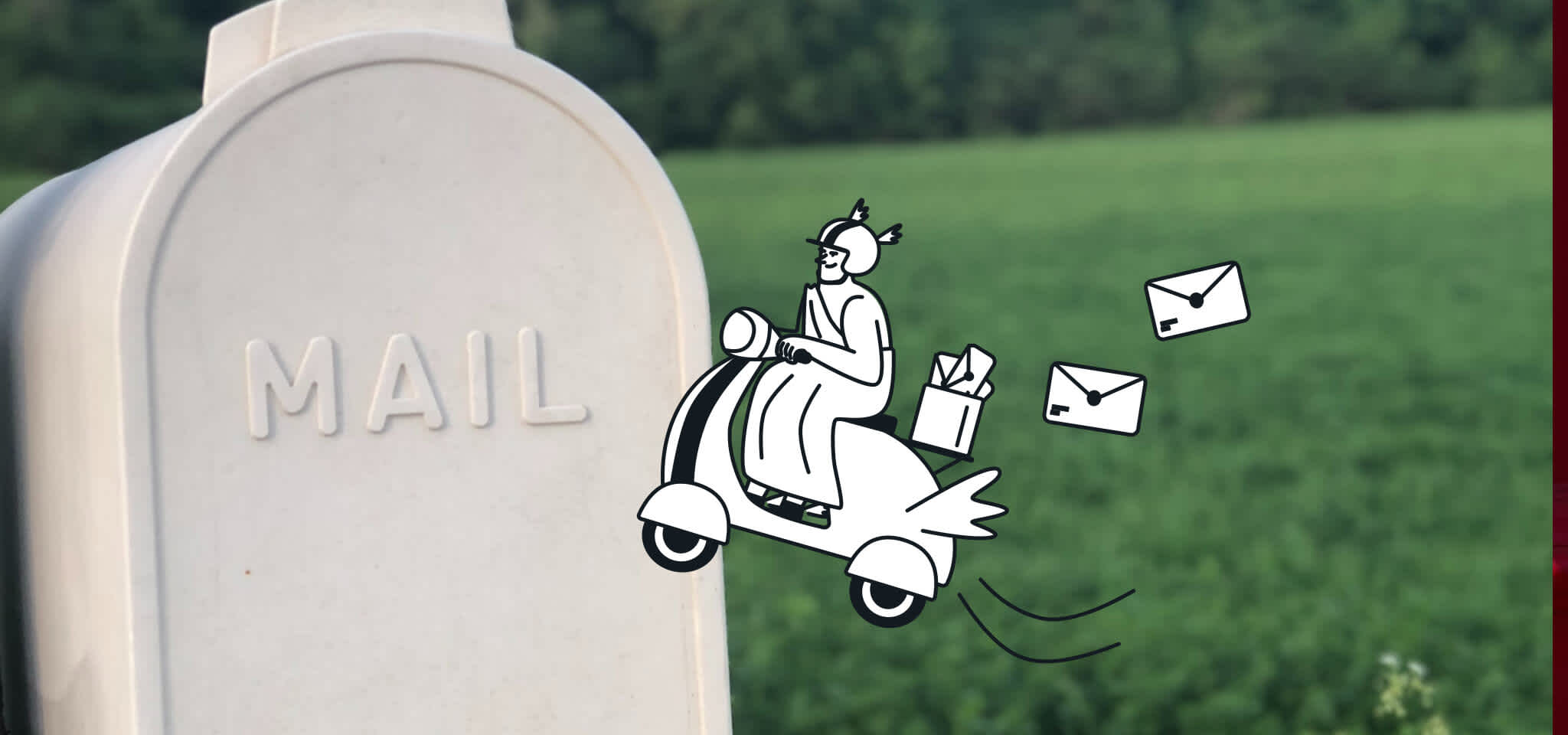Email best practices
How to grow your email list: 20 simple ideas
Learn how to increase your email list. Discover 20 ideas from top experts on how you can gain new subscribers and increase your contact list.

PUBLISHED ON
Have you ever experienced the bitter sensation of spending hours preparing an email campaign, only to see some of your readers unsubscribe? A disappointment like this can only be compared with doing the best exam of your life at school only for the teacher to then lose the exam papers.
Yet, although the loss of a valued contact may be painful, you shouldn’t let this affect your confidence.
Instead, focus on what you can control. Contacts will naturally unsubscribe due to changing jobs, inbox providers, or interests. But you can also grow your email list with new and engaged contacts that will keep your email list alive and constantly driving value.
Feeling more relaxed yet? Good, then let’s begin exploring our proven email list building tactics to grow your list fast.
Table of contents
1. Include subscription forms on prominent pages
2. Use pop-ups to capture website visitors
3. Sell your newsletter on the blog
4. Create and share landing pages
5. Find the right audience with social ads
6. Add subscription links to your social media pages
7. Launch a competition among your social followers
8. Offer promotions and exclusive discounts
9. Leverage your premium content
10. Try email blogging with exclusive content
11. Create newsletters with the potential to go viral
12. Promote your contact list in your physical shop
13. Collect email addresses at events
14. Increase your list over the phone and via support channels
15. Leverage social proof
16. Gamify your website to drive subscriptions
17. Produce high-quality newsletters
18. Encourage sharing with friends
19. Exchange guest blog posts
20. Add a signup option to surveys
What is an email list?
An email list is simply a collection of email addresses that have been collected from people who have filled out a signup form and agreed to receive emails. Your email list can be used for various purposes, such as sending newsletters, promotional emails, updates, and other important information.
An email list often includes contact data beyond the recipient’s email address, providing marketers with valuable personal information that allows email campaigns to be, personalized, and maximize results.
Building and growing your email list is the first step to a profitable email marketing program, which often drives impatient or inexperienced marketers to purchase or rent subscriber lists, a classic email deliverability mistake.
Your email marketing program is only as strong as your email database, so let’s look at why you should make list growing a healthy email list a top priority for your email marketing strategy, and how to do it effectively.
Why you should grow your email list
Despite what you may think at first, having an unsubscribe rate of between 0.2 and 0.4% (depending on the industry) is actually quite reasonable I. It doesn’t mean that your last email is of poor quality – it’s just the traditional "lifecycle" of an email list.
Far from being set in stone, an email list is a living, breathing entity. In order to make sure that our contact list is healthy and accounts for unsubscribes, it’s essential to attract new subscribers who enrich our contact list.
An email list is the engine that drives your email marketing efforts. Just like a real engine, your email list needs to be fed with time and energy and maintained regularly to work efficiently. The result of email building efforts has a far-reaching impact on your total marketing reach, including:
Reaching your targeted audience
Nurturing relationships with subscribers
Increasing website traffic
Boosting sales
Building brand awareness
Gaining insights into your audience
Increasing social media engagement
Let’s look at how we can get your email marketing engine stoked and running at full speed.
20 ideas to grow your email list
If you see that your list is not growing or, even worse, that it’s decreasing, it’s probably time for you to review your contact acquisition strategy. A list growth strategy is vital for an effective email marketing strategy and is a bit like a marathon where it is not the fastest who wins but the one who shows the most persistence. Kind of like the story of The Tortoise and the Hare.
1. Include subscription forms on prominent pages
It doesn’t matter whether you’re a New York Times best seller, influencer, or S&P500 corporation – subscription forms need to be prominent on your website. The homepage is the gateway of every website and is responsible for the most traffic, so it’s an obvious starting point. From there you want to utilize the navigation bar and blog articles.
Once you have your subscription form plastered across the most prominent areas of your website, use Google Analytics to discover other hotspots where your visitors are going. Perhaps your podcast pages or shop are bringing large swathes of traffic into your domain. Experiment and compare the results until you find the best bang for your buck, or in this case, subscribers for your website space.
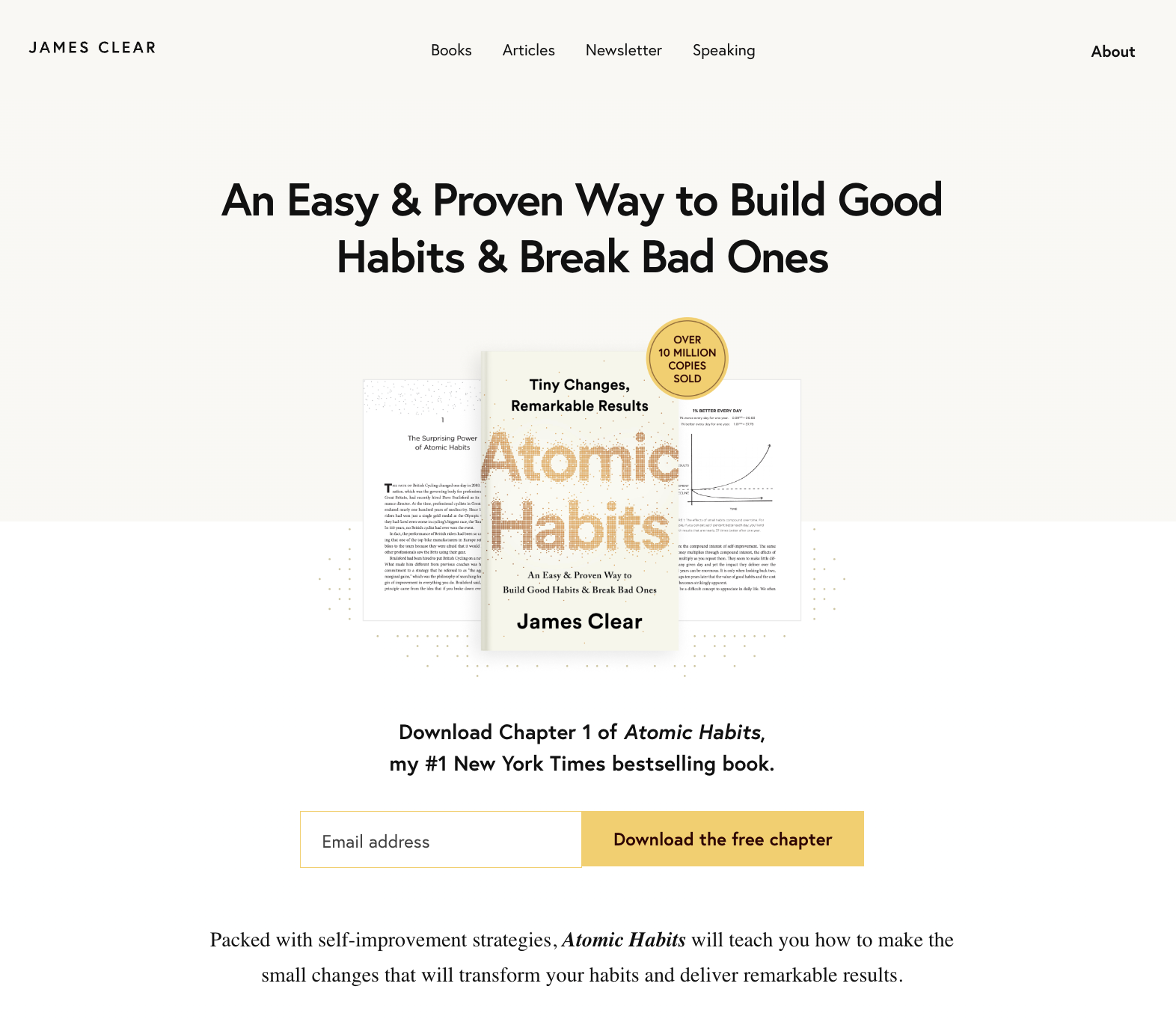
Growth hacker and author James Clear has a signup form on his homepage.
Use Mailjet’s drag-and-drop Form Builder to easily create beautifully branded signup forms for your website.
2. Use pop-ups to capture website visitors
At the same time, you can also use tools dedicated to gathering email addresses. For example, Poptin is a free tool that allows you to incorporate a pop-up window, which includes a subscription form to your newsletter when the visitor is about to leave your site. Integrated into Mailjet, this type of tool could increase your daily subscriptions by up to 10%. Sounds good, right?
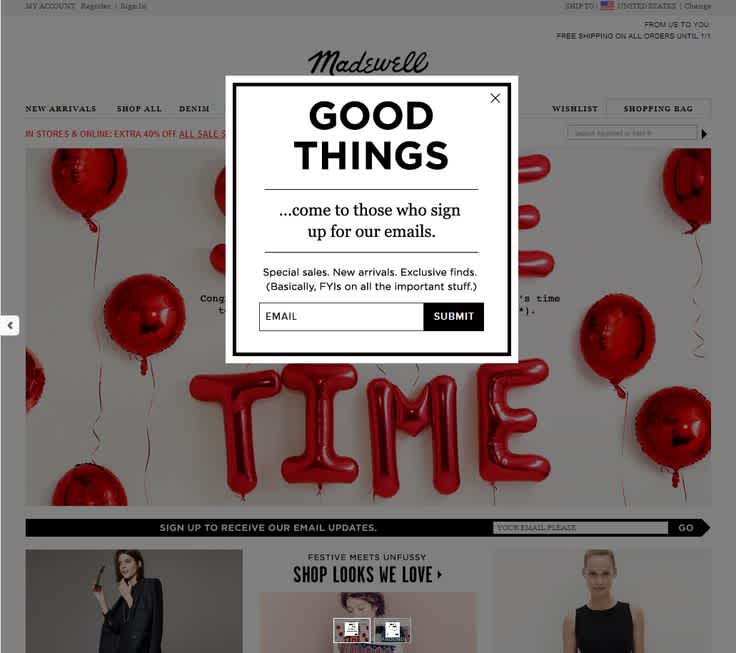
The key to getting the best results is to try various locations, designs, and text to determine the best place to position it. Fundamentally, you want to find the place with the best conversion potential, without compromising user experience.
3. Sell your newsletter on the blog
If you use your newsletter to share content from your blog, don’t miss the chance to remind your users of the added value of your weekly bulletins. Take the opportunity to include banners within your content and explicit references with URL links to articles or advice shared via the newsletter.
But be careful, you can be too aggressive with this kind of cross-promotion. Be sure to respect the reader’s time and energy by spacing out mentions of your newsletter. Think of the analogy of a pushy retail salesman versus someone gently asking, "Can I help you with anything today?”
4. Create and share landing pages
As well as subscription forms on main pages, it’s essential to design specific landing pages to encourage website visitors to subscribe to your newsletter. This is because landing pages are optimized to attract more traffic and encourage conversions and may be linked from different parts of your website or external pages. For example, you could include a link to one of your publications on social networks, or at the end of a guest post for an external blog, encourage readers to subscribe to your newsletter.
Don’t forget to include a link to this form in your transactional emails and email signatures of your employees, so that every non-marketing email you send also becomes an opportunity to increase your contact list.
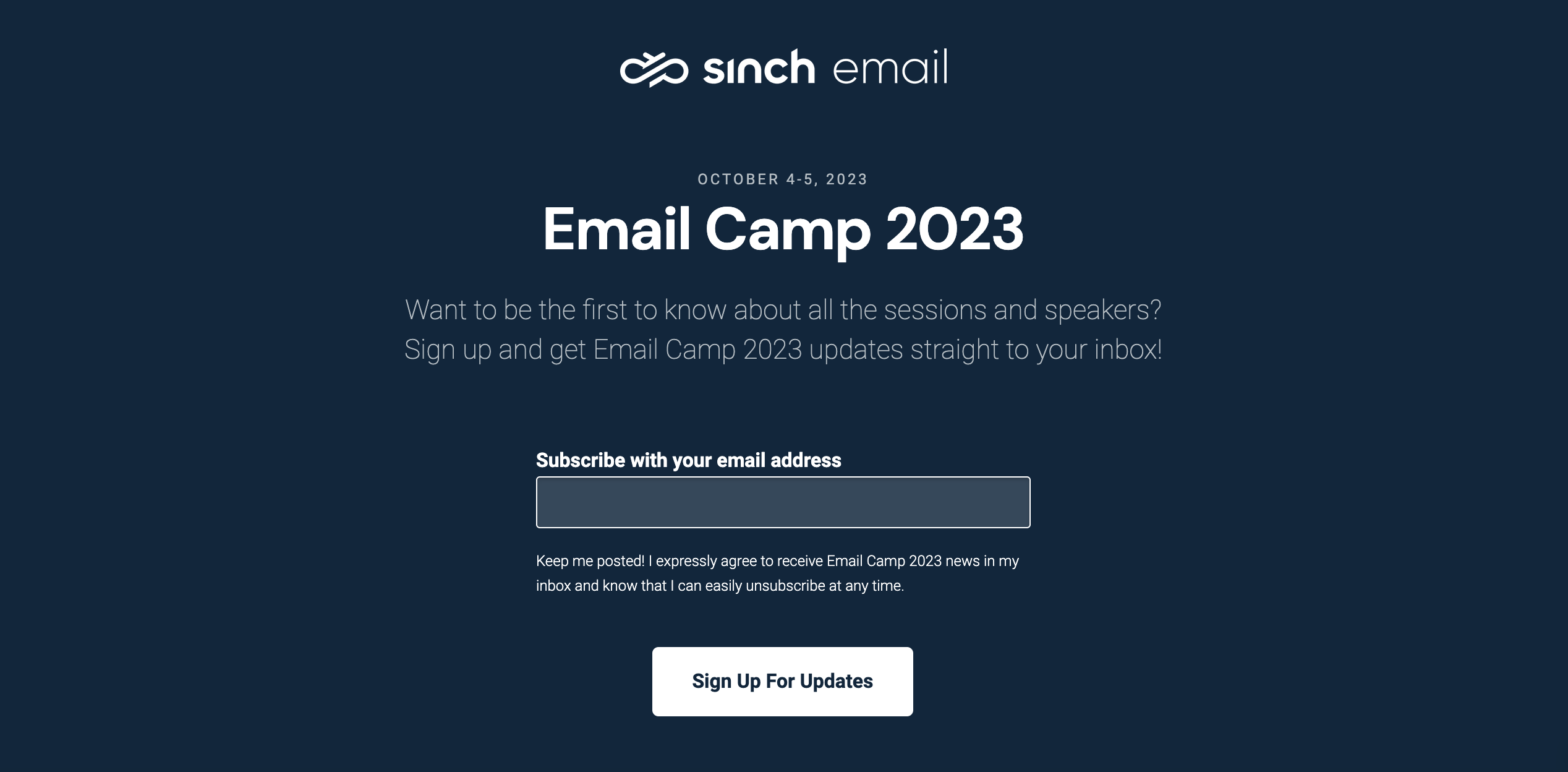
Mailjet's Email Camp 2023 landing page is simple and straight to the point.
5. Find the right audience with social ads
When configuring your ads on social networks like Meta, LinkedIn, and Google Adwords, segmentation tools are so advanced that you can sift through a multitude of granular demographic combinations easily.
Why is that important? Well, you could promote your blog publications, your commercial promotions, and guides as well as launch specific campaigns to encourage users to join your mailing list.
Still not clear? Discover how Loïc Le Meur attracted over 1,500 new subscribers to his Mailjet email list in a single year.
6. Add subscription links to your social media pages
Make sure that you include direct links to your newsletter on your social network pages, either with CTAs like those offered by Facebook (Sign up), or through pinned posts or links in the ”about” section (below).
You can also schedule posts every so often, including an example of your newsletter to get people to subscribe, or relaunch particularly successful publications, adding an invitation to join the newsletter not to miss out on the “latest post like this.”

Mailjet’s Twitter page features an email signup link.
7. Launch a competition among your social followers
A great way to quickly boost your social media followers is launching a competition. Nothing gets people’s blood running high like the prospect of free money, gifts, or experiences.
For example, you could announce that you will be holding a draw for a special gift among all of your email subscribers at the end of each month or between subscribers who have signed up within a certain period.

Social media is a great place to fish for new subscribers.
8. Offer promotions and exclusive discounts
Offering discounts and unique offers will encourage lots of people to join your list in a very short time. In The Path to Email Engagement report, 50.2%of respondents say they would click through to learn more about the offer or use the promo code on a discount email. Therefore, don’t underestimate the power of giving money in return for email sign ups.
Of course, there’s always the risk that some people may only subscribe to your deal and leave shortly after. In this case, it’s good to understand exactly what attracted them to your signup page in the first place and continue offering them similar value in your campaigns to avoid churn.
Some companies choose to launch this type of campaign on a seasonal basis, during the Christmas period or during sales, while others spread them out over the year. Overall, a more scattered strategy would be preferable to avoid users leaving your list once the season in question has come to an end.
However, don’t become like every sofa store offering discounts and sales all-year-round, or you’ll lose trust, be scrutinized, and even made into a meme!
9. Leverage your premium content
Premium content comes in many forms: reports, whitepapers, webinars, and case studies to name a few. It’s premium because it takes more time and energy to produce compared to blog posts and webpages and offers the reader significant value.
An easy way to boost premium content and therefore email signups is by cross-posting banners and CTA in relation to your premium content like blog articles or strategic pages of your website. But remember, it’s a legal requirement to either include an opt-in check box to your form or state that by entering their information, they consent to receiving emails.
You could also use premium content to reach an audience that is as yet unfamiliar with you, promoting them on social networks, in guest articles, and ads. The more you invest in promoting your premium content, the higher the ROI you receive on them.
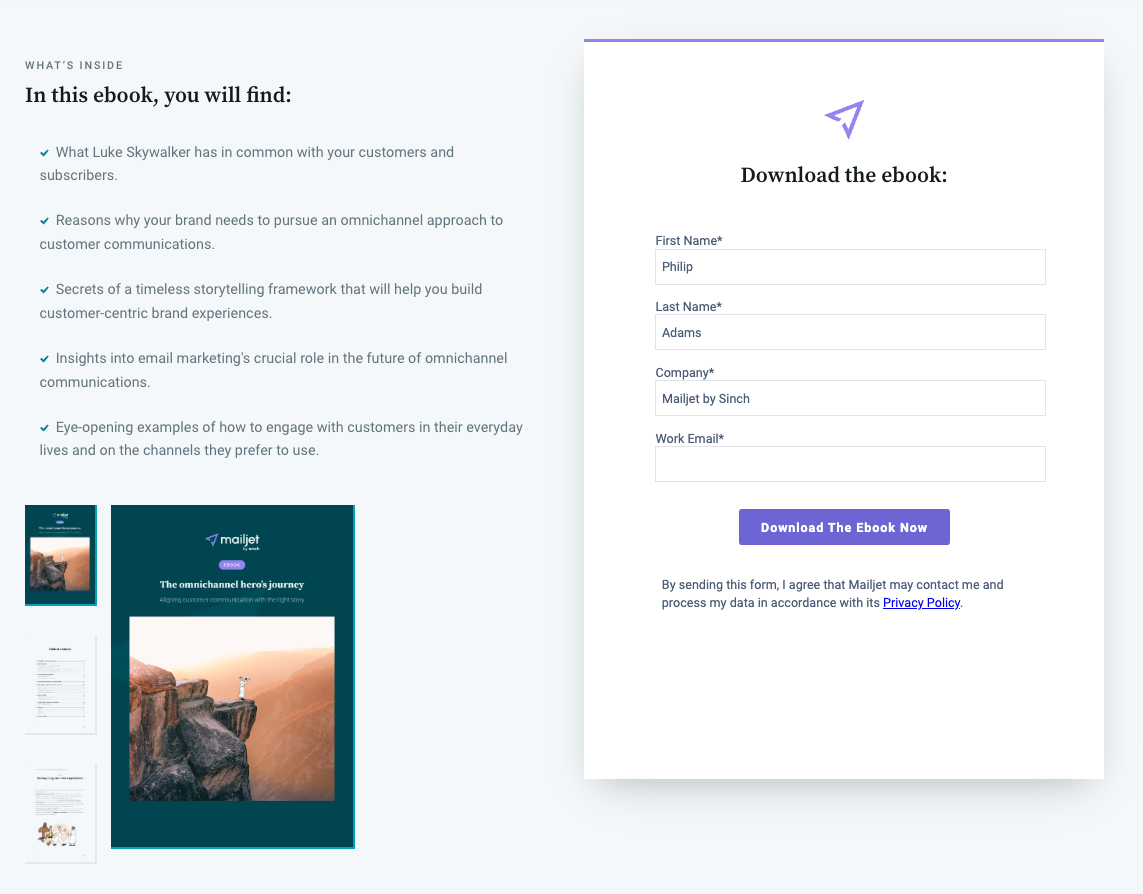
Mailjet’s Inbox Insights 2023 report is gated and requires user’s data.
10. Try email blogging with exclusive content
Offering exclusive content only via email is a way of giving your emails unique value and developing a deeper connection with your audience. This practice is known as email blogging and consists of sharing stories and personal insights via email only.
Essentially, it involves creating an exclusive club of readers and encouraging people to join by making a clear promise of value and setting expectations of frequency. Email blogging has become wildly popular in recent years with the likes of Maria Popova’s The Marginalian (formerly Brain Pickings), Tim Ferris’ 5-Bullet Friday, and James Clear’s The 3-2-1 Newsletter.
Marketing expert Daniel Bonilla gave us some advice in our post: 5 tips to reinvent your content marketing strategy for email.
“If there are two things that I recommend for email blogging, they are consistency and persistence. Always write with the same frequency and, if possible, always send on the same day and at the same time. If your subscribers know that, whether it rains or shines, your email will arrive at the same time on the same day of the week...they will go and look for it in the spam folder if it hasn't arrived. Don’t expect overwhelming success overnight. We're not talking about visits, but about subscribers and ensuring that 200 or 300 people receive your emails and, above all, read them – it’s a major achievement. Reaching 2000 or 3000 people is something that is only achieved with time, patience, and effort to generate quality content. But the payoff is huge.”
David Bonilla, marketing expert and founder of Bonillaware
11. Create newsletters with the potential to go viral
Another way to put your contact list in front of a new audience is to create email newsletters with the potential to go viral. Yes, we know, finding the key to viral content isn’t that simple...otherwise everyone would be doing it, and then by nature, wouldn’t be viral.
There’s no secret sauce to going viral, but here are some brilliant examples from over the years:
Hotmail launch: In 1996, Hotmail launched its email service and included a simple message at the bottom of each email that said, "PS: I love you. Get your free email at Hotmail." This simple message went viral and helped Hotmail acquire millions of users in a short amount of time.
Obama campaign: During the 2008 U.S. presidential election, the Obama campaign sent emails with catchy subject lines, personalized messaging, and powerful CTA to engage supporters and encourage them to donate and get involved in the campaign.
Dollar Shave Club welcome email: In 2012, Dollar Shave Club sent out a welcome email to new subscribers that went viral. The email used jokes and witty copywriting to engage and entertain subscribers and helped to establish the brand's unique voice and personality.
Charmin "Sit or Squat" app: In 2008, Charmin created an app called "Sit or Squat" that allowed users to find and rate public restrooms. The company sent out an email promoting the app that went viral due to its hilarious content and catchy subject line: "Charmin Asks: To Sit Or To Squat?"
Chewbacca’s mom: In 2016, Candace Payne posted a video of herself laughing hysterically while wearing a Chewbacca mask from Kohl’s. The video went viral and was shared millions of times on social media. Later, Kohl's sent her an email thanking her for shopping with them and offering her more Star Wars merchandise. The email also went viral and helped to reinforce Kohl's brand as fun and light-hearted.
If you want to create a viral campaign, try getting your team together in an informal environment to brainstorm ideas. Alternatively, PR agencies are always dreaming up media attention grabbing ideas and could help drum up some sharable email campaigns.
12. Promote your contact list in your physical shop
A brick-and-mortar store is a perfect place to ask your customers to subscribe to your contact list. Unlike the random and anonymous nature of the internet, these clients have experienced your brand first-hand.
You can capture this engagement either through a traditional visitors’ book or by having the landing page with your subscription form open on a smartphone, tablet, or computer. Remember that it is important that your clients give their express consent and that you have a record to verify this consent.
Every customer can become a subscriber. For example, when a client buys a pair of jeans in a clothes shop, you could offer them the option of signing up to your mailing list to receive exclusive discounts and the latest catalogs.
13. Collect email addresses at events
If you’ve spent money for a stand at a trade fair or event, collecting email addresses is a must. That’s because everyone at the event is going to be your ideal target audience.
When someone shows an interest or buys one of your products or services, highlight the value offered by your email campaigns and encourage visitors to join to keep up-to-date.
You could also organize a competition to encourage people to join, although raffles and prizes will always lose people if they have no real interest in receiving your emails.
14. Increase your list over the phone and via support channels
Another option that many companies forget to leverage is promoting their email list via support channels. In other words, customer service telephone numbers, chats, or designated emails.
Of course, you are not going to suggest to any angry user to sign up for your newsletter, but it could be useful to suggest this to clients who contact you about your services or the latest updates.
For example, if someone phones or emails to ask if one of your products will be coming back into stock, you could reply and encourage them to sign up to your email database to be first to see the new catalog or learn about next season’s products or services.
In any case, make sure that you have a system that lets you verify that your contacts have given their explicit consent, which is mandatory under GDPR.
15. Leverage social proof
When we open any new social media page, we tend to check the like, follow, or love counter. Why? Because it’s the first step in legitimizing the person or organization you’re evaluating. We do it so often that it’s unconscious. This is the game of social proof.
Here are a few ways to add social proof to your signup forms:
Subscribers' testimonials
Social share counts
Subscriber count
Influencer endorsements
Media mentions
User-generated feedback
It’s just as important for people as it is for businesses to have a reputable following before being taken seriously. Social proof shows your customers that you’re not just some cowboys looking to take their money. This translates directly to email newsletters, which often have a subscriber count on the landing page or signup widget.
16. Gamify your website to drive subscriptions
We’ve all been hooked on a mobile game at one point or another – we can’t get enough of the dopamine hit of reward-based games. You can use the same psychological reward system to generate email signups on-page.
Luckily, you don’t need to waste hours of customer’s time and attention to generate a signup. You can use fun popups with quick games like spin the wheel, pick a gift, or scratch cards to tempt the reader’s attention with a prize. Prizes can vary from discounts to free gifts, or access to an otherwise paid piece of content.
For companies that manage user accounts, a point-based reward system can encourage users to complete actions on your website like signing up or sharing your newsletter. Between badges, achievements, or scoreboards, you can encourage users to take pride in the investment in your brand. These points not only garner competition between peers but could be redeemed for discounts and offers as an upsell incentive.
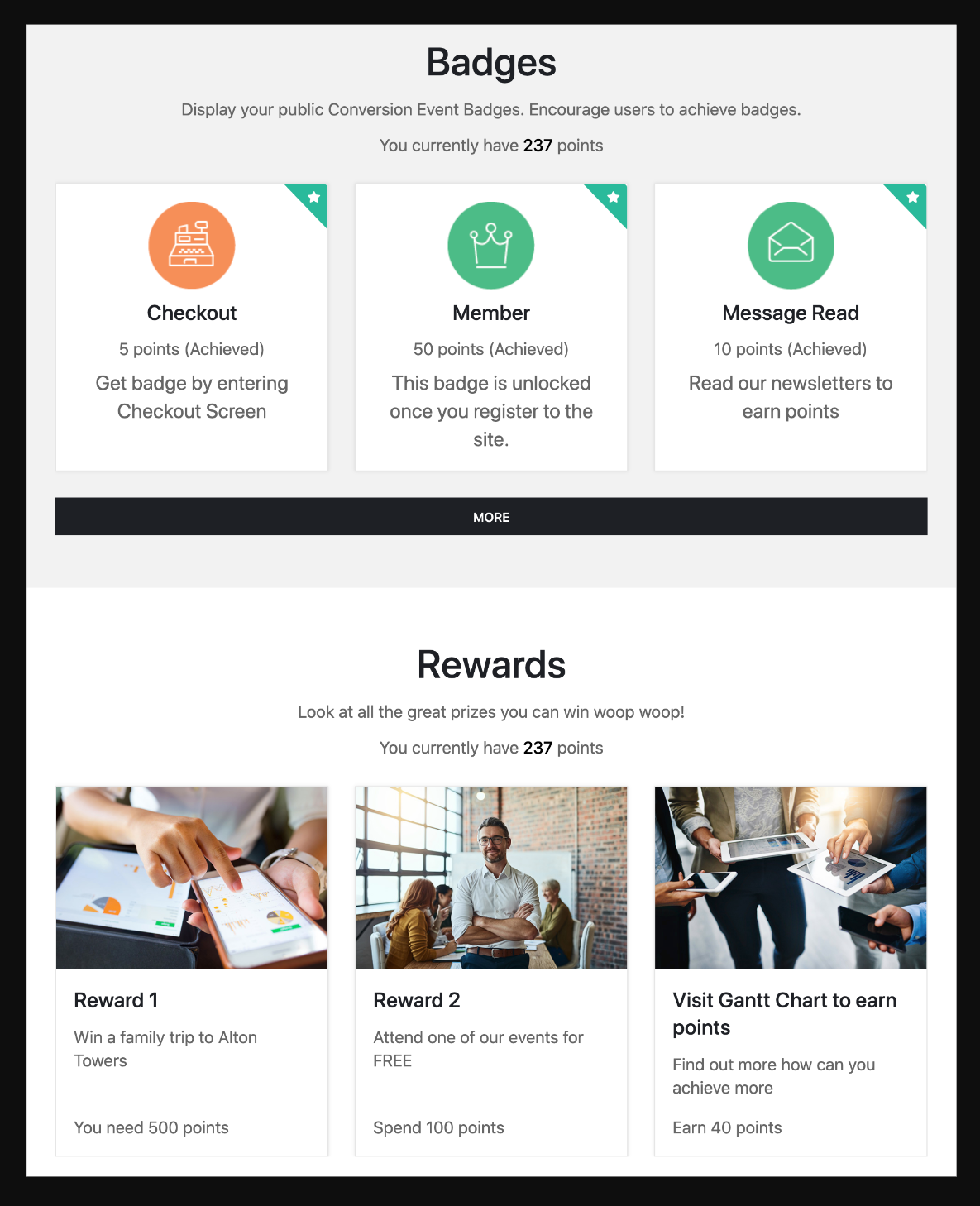
Reward users for completing actions like reading your newsletter.
17. Produce high-quality newsletters
As marketers, we’re constantly facing the “leaky bucket” dilemma, where email lists are leaking subscribers every day. It’s not personal – people change jobs, mailbox providers, and unsubscribe to emails all the time.
A solid content marketing strategy is the bedrock of all successful newsletters. Without high-quality content, your leaky bucket is going to become a sinking ship. No matter how strong your list building acquisition may be, delivering half-baked campaigns is going to turn your readers off.
How do we plug the hole in our leaky bucket? That, unfortunately, is impossible even for the most engaging senders like Apple. But it is possible to stem the leak. This mostly comes down to following email best practices and providing quality content to your readers. Luckily, we’ve compiled all the best practices in our email marketing playbook.
18. Encourage sharing with friends
If you produce something really interesting for your readers to contemplate, they will naturally want to share it with friends. But that’s impossible if you haven’t added any functionality to make this a reality.
With ESPs like Mailjet, this is a relatively easy fix. You can add social sharing buttons to your template as well as a note to forward to their friends.

Shuka Design Bureau encourages readers to share their emails on social media.
19. Exchange guest blog posts
When it comes to the business of email list growth, there is no greater leverage than teaming up with others. By combining the SEO authority and collective audience of two non-competing brands, you can reach customers quickly in a good old-fashioned trade.
While it’s illegal to simply exchange list data, you can trade guest blog posts with another company to reach their audience. This blog post can either overtly advertise the value of joining your email list or cover a related topic. Make sure to add CTAs, links, or a widget taking the reader back to your newsletter landing page.
Use UTM tags to track the effectiveness of your blog posts so you can decide which brands are worth collaborating with in the future.
20. Add a signup option to surveys
Any marketer worth their salt should be actively seeking feedback from their audience to steer a broader marketing strategy. And surveys are one of the best ways to understand what your company is doing right and wrong.
To validate the results, an email address is usually required within the form. By just adding an opt-in checkbox to this process, marketers can ask participants if they would like to be added to your email database.
In Mailjet’s recent call for participants for our report, Inbox Insights 2023, we added a competition to win a $50 Amazon gift card. Little incentives can go a long way in boosting signup engagement.
A/B testing is crucial to understanding the effectiveness of these email list growing strategies. If a strategy is using resources but not converting readers to subscribers, move on to the next tactic.
How can you grow your email list with Mailjet?
We covered a lot of different approaches to list building today, so it’s understandable that you might feel a little overwhelmed. The best thing to do is try one at a time and measure the results closely.
But without a doubt, signup forms are the crux of every tactic shared here today. A well-designed variety of signup forms are sure to convert readers into tangible leads for your business.
Luckily, Mailjet’s Form Builder enables you to build contact lists that convert customers for life. Creating great forms is as easy as dragging and dropping bespoke fields with imagery, text, CTAs, and more. Give it a try for free today.
Form builder
Convert visitors with our subscription form builder
Create your subscription form using our drag-and-drop designer and grow your contact lists. Mailjet’s Form Builder offers a native double opt-in which guarantees your recipients' interest - an essential prerequisite for your reputation as a sender and GDPR.




